Researchers and clinicians from the research team co-directed by Prof. Marc SANSON and Emmanuelle HUILLARD at the Paris Brain Institute have just identified four molecular profiles of primary central nervous system lymphoma (PCNSL) that could predict the disease evolution and the risk of recurrence, allowing to orient patient care towards more effective therapies.
Primary central nervous system lymphomas
Primary central nervous system lymphomas are characterized by the proliferation of B lymphocytes, immune cells whose role is to defend the body against viruses and bacteria.
PNSCLs develop in the brain, meninges (membranes surrounding the brain), spinal cord and eyes and account for 5% of malignant brain tumors.
These tumors affect 400 new people each year and there is an increase in the number of new cases in the elderly, with those over 60 years of age accounting for over 70% of cases.
The diagnosis of these tumors is based on brain imaging and the dosage of an interleukin, an immune molecule in the cerebrospinal fluid associated with clinical symptoms such as cognitive and behavioral disorders, and signs of intracranial hypertension. Nevertheless, clinical and radiological features presented by patients are very heterogeneous leading to diagnosis difficulties.
A diagnosis and therapeutic orientation assistance
The work of Agusti ALENTORN, a neurologist and researcher in the “GENETICS AND DEVELOPMENT OF BRAIN TUMORS” team, aimed to define molecular profiles to help in the diagnosis and to establish an earlier adapted therapeutic management. The study involved the analysis of brain tissues from 250 patients with CNSPA associated with clinical and radiological criteria.
The joint analysis of these data lead to identify four specific patient profiles associated with a prognosis of more or less severe and rapid evolution. These results, published in the prestigious journal Annals of Oncology, will allow to better evaluate each patient with LPSNC, thus reducing the time to diagnosis and allowing for earlier and more targeted therapy.
Source : Ann Oncol. 2022 Nov 16:S0923-7534(22)04732-9. doi: 10.1016/j.annonc.2022.11.002. Epub ahead of print. PMID: 36402300.









